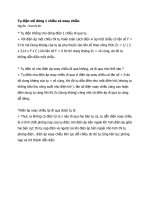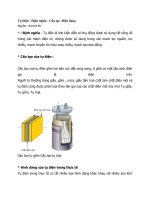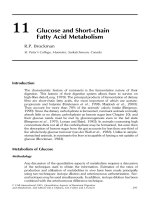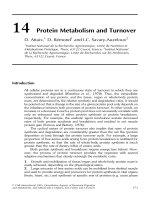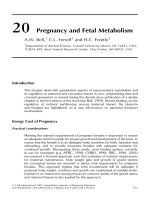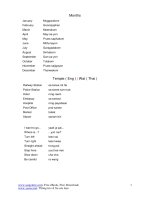Tài liệu Tự điển Food Science, Technology And Nutrition - Vần D ppt
Bạn đang xem bản rút gọn của tài liệu. Xem và tải ngay bản đầy đủ của tài liệu tại đây (186.55 KB, 19 trang )
cytochromes haem-containing proteins. Some react with oxygen
directly; others are intermediates in the oxidation of reduced
coenzymes. Unlike haemoglobin, the iron in the haem of
cytochromes undergoes oxidation and reduction.
cytochromes P450 A family of cytochromes involved in the
detoxication system of the body (see phase i metabolism). They
act on a wide variety of (potentially toxic) compounds, both
endogenous metabolites and foreign compounds (xenobiotics),
rendering them more water-soluble, and more readily conjugated
for excretion in the urine.
The CYP26 group of cytochromes P450 are specific for
retinoic acid, leading to a variety of metabolites that may be
physiologically active (especially in cell differentiation), includ-
ing 4-hydroxy-, 4-oxo-, 5,6-epoxy- and 18-hydroxy-retinoic acid.
cytokines A number of proteins secreted by cells in response to
various stimuli that act to regulate proliferation and differentia-
tion, immune and inflammatory responses, etc.
Cytokines produced by lymphocytes are sometimes known as
lymphokines; those from monocytes as monokines; those
secreted by adipose tissue as adipokines or adipocytokines.
cytokinins Plant hormones derived from isopentenyl adenosine;
produced by root tips, seed embryos, developing fruits and buds;
they stimulate cell division (cytokinesis) and regulate develop-
ment of the plant.
See also auxins.
cytosine One of the pyrimidine bases of nucleic acids.
D
D
-,
L
- and
DL
- Prefixes to chemical names for compounds that
have a centre of asymmetry in the molecule, and which can
therefore have two forms.
Most naturally occurring sugars have the d-conformation;
apart from a few microbial proteins and some invertebrate
peptides, all the naturally occurring amino acids have the l-
configuration. Chemical synthesis yields a mixture of the d- and
l-isomers (the racemic mixture), generally shown as dl-.
See also isomers; optical activity;
R
- and
S
-.
d- and l- An obsolete way of indicating dextrorotatory
and laevorotatory optical activity, now replaced by (+) and
(−).
dabberlocks Edible seaweed, Alaria esculenta.
dadhi See milk, fermented.
dagé Indonesian; fermented presscake from various oilseeds or
legumes or starch crops, soaked in water and left to undergo
144
bacterial fermentation (mainly Bacillus spp.) to form a glutinous
mass bound by bacterial polysaccharides.
dahl See legumes.
dahlin See inulin.
daikon Radish, large Japanese variety of Raphanus sativus. Often
pickled in soy sauce, and an ingredient of kimchi.
daily value Reference amounts of energy, fat, saturated fat, car-
bohydrate, fibre, sodium, potassium and cholesterol, as well as
protein, vitamins and minerals, introduced for food labelling in
USA in 1994. The nutrient content of a food must be declared
as percentage of the daily value provided by a standard serving.
Dairy-Lo
TM
fat replacer made from protein.
Daltose
TM
A carbohydrate preparation consisting of maltose,
glucose and dextrin for infant feeding.
damiana Leaf and stem of Turnera diffiusa var. aphrodisiaca, used
as a food flavouring, reputed to have aphrodisiac and antide-
pressant properties.
damson Small dark purple plum (Prunus damascena); very acid,
mainly used to make jam. Introduced into Europe by Crusaders
returning from Damascus (early 13th century).
dandelion The leaves of the weed Taraxacum officinale may be
eaten as a salad or cooked. In France dandelion greens are
known as pis-en-lit because of their diuretic action.
Composition/100 g: water 86g,188kJ (45kcal), protein 2.7 g, fat
0.7 g, carbohydrate 9.2g (3.8g sugars), fibre 3.5g, ash 1.8g, Ca
187 mg, Fe 3.1 mg, Mg 36 mg, P 66 mg, K 397 mg, Na 76 mg, Zn
0.4 mg, Cu 0.2 mg, Mn 0.3 mg, Se 0.5 µg, vitamin A 247 µg RE
(9607 µg carotenoids), E 4.8 mg, K 273.7mg, B
1
0.19 mg, B
2
0.26 mg, niacin 0.8 mg, B
6
0.25 mg, folate 27 µg, pantothenate
0.1 mg, C 35 mg.
The root can be cooked as a vegetable, or may be roasted and
used as a substitute for coffee.
Danish agar See furcellaran.
dansyl reagent 5-Dimethylamino naphthalene sulphonic acid;
reacts with amino terminal amino acid of a peptide to give a flu-
orescent derivative which can be identified by thin-layer chro-
matography after hydrolysis of the peptide.
danthron An anthroquinone stimulant laxative.
dark adaptation In the eye, the visual pigment rhodopsin is
formed by reaction between vitamin a aldehyde (retinaldehyde)
and the protein opsin, and is bleached by exposure to light, sti-
mulating a nerve impulse (this is the basis of vision). At an early
stage of vitamin A deficiency it takes considerably longer than
normal to adapt to see in dim light after exposure to normal
bright light, because of the limitation of the amount of rhodopsin
145
that can be reformed. Measuring the time taken to adapt to dim
light (the dark adaptation time) provides a sensitive index of
early vitamin A deficiency. More severe vitamin A deficiency
results in night blindness, and eventually complete blindness.
dasheen See taro.
date Fruit of date palm, Phoenix dactylifera.Three types: ‘soft’
(about 80% of the dry matter is invert sugar, see sugar, invert);
semi-dry (about 40% invert sugar, 40% sucrose); and dry
(20–40% invert sugar, 40–60% is sucrose).
Composition/100 g: (edible portion 90%) water 20.5 g, 1180 kJ
(282 kcal), protein 2.5 g,fat 0.4g,carbohydrate 75 g (63.3 g sugars),
fibre 8 g, ash 1.6 g, Ca 39 mg, Fe 1 mg, Mg 43 mg, P 62 mg, K 656 mg,
Na 2 mg, Zn 0.3 mg, Cu 0.2 mg, Mn 0.3 mg, Se 3 µg, 81 µg
carotenoids, vitamin E 0.1 mg, K 2.7 mg, B
1
0.05 mg, B
2
0.07 mg,
niacin 1.3 mg, B
6
0.17 mg, folate 19 µg, pantothenate 0.6mg.
date, Chinese See jujube (2).
DATEM Diacetyl tartaric esters of mono- and diglycerides used
as emulsifiers to strengthen bread dough and delay staling (E-
472e).
date marking ‘Best before’ is the date up until when the food will
remain in optimum condition, i.e. will not be stale. Foods with a
shelf-life up to 12 weeks are marked ‘best before day, month,
year’; foods with a longer shelf-life are marked ‘best before end
of month, year’.
Perishable foods with a shelf-life of less than a month may
have a ‘sell by’ date instead. ‘Use by’ date is given for foods that
are microbiologically highly perishable and could become a
danger to health; it is the date up to and including which the food
may safely be used if stored properly.
Frozen foods and ice cream carry star markings that corre-
spond to the star marking on freezers and frozen food compart-
ments of refrigerators. One star (*) −4°C (25 °F) will keep for
one week; two star (**) −11°C (12 °F), 1 month; three star (***)
−18 °C (0 °F), 3 months. Corresponding times for ice cream are 1
day, 1 week, 1 month, after which they are fit to eat but the
texture changes.
date plum See persimmon.
dawadawa African; fermented dried seeds of the African locust
bean Parkia biglobosa, usually pressed into balls; various bacte-
ria are involved in the 3–4 day fermentation.
db/db mouse Genetically obese mouse that is also diabetic; the
defect is lack of leptin receptors.
DBD process See dry–blanch–dry process.
DCPIP See dichlorophenolindophenol.
DCS Distributed control systems.
146
DE See dextrose equivalent value.
debranching enzymes Enzymes that hydrolyse the α-1,6 glyco-
side bonds that form the branch points in amylopectin. Amy-
loglucosidase (EC 3.2.1.3) and glucoamylase (EC 3.2.1.20) also
hydrolyse α-1,4 links; pullulanase (EC 3.2.1.41) and isoamylase
(EC 3.2.1.68) hydrolyse only α-1,6 links.
See also amylases; z-enzyme.
debrining Removal of much of the salt used in brining vegeta-
bles, to a level that will be acceptable in the final product. Also
known as freshening.
decimal reduction time (D value) Term used in sterilising canned
food, etc.; the duration of heat treatment required to reduce the
number of micro-organisms to one-tenth of the initial value, with
the temperature shown as a subscript, e.g. D
121
is time at 121 °C.
defoamer See antifoaming agents.
DEFRA UK Department of the Environment, Food and Rural
Affairs; web site />defructum Roman; cooking wine that has been reduced to half its
volume by boiling.
DEFT Direct Epifluorescence Filter Technique for measuring
bacterial content of milk and other fluids by passing through a
fine pore filter to retain bacteria that are then stained with acri-
dine orange to permit fluorimetric quantification. A rapid and
sensitive alternative to plating out a sample, culturing and count-
ing the resultant bacterial colonies. Trade names for the equip-
ment used include Biofoss, Bactoscan and Autotrak.
deglutition The act of swallowing.
degumming Removal of proteins, phospholipids, gum, resin, etc.
in the refining of oils and fats by the addition of dilute hydrochlo-
ric or phosphoric acid, brine or alkaline phosphate solution.
Permits recovery of lecithin from the aqueous phase.
dehydroascorbic acid The oxidised form of vitamin c which is
readily reduced back to the active form in the body, and there-
fore has vitamin activity. Not measured by all methods for
vitamin C estimation.
See also ascorbic acid.
dehydrocanning A process in which 50% of the water is removed
from a food before canning. The advantages are that the texture
is retained by the partial dehydration and there is a saving in
bulk and weight.
7-dehydrocholesterol Intermediate in the synthesis of choles-
terol, and precursor for the synthesis of vitamin d in the skin.
dehydrofreezing A process for preservation of fruits and vegeta-
bles by evaporation of 50–60% of the water before freezing. The
texture and flavour are claimed to be superior to those resulting
147
from either dehydration or freezing alone, and rehydration is
more rapid than with dehydrated products.
dehydroretinol An analogue of vitamin a found in freshwater
fish, which has about half the biological activity of retinol.For-
merly termed vitamin A
2
.
Delaney Amendment Clause in the US Federal Food, Drug and
Cosmetic Act (1958) which states that no food additive shall be
deemed safe (and therefore may not be used) after it is found to
induce cancer when ingested by man or animals, at any dose
level.
delayed hypersensitivity An adverse reaction to food, occurring
several hours after ingestion, caused by cell-mediated immune
responses (activated lymphocytes) as opposed to immunoglobu-
lin-mediated responses, which occur rapidly.
See also coeliac disease.
demerara sugar See sugar.
denaturation A normally irreversible change in the structure of
protein by heat, acid, alkali or other agents which results in loss
of solubility and coagulation. Denatured proteins lose biologi-
cal activity (e.g. as enzymes), but not nutritional value. Indeed,
digestibility is improved compared with the native structure,
which is relatively resistant to enzymic hydrolysis.
denatured alcohol See alcohol, denatured.
dendritic salt A form of ordinary table salt, sodium chloride, with
the crystals branched or star-like (dendritic) instead of the
normal cubes. This is claimed to have a number of advantages:
lower bulk density, more rapid solution, and an unusually high
capacity to absorb moisture before becoming wet.
density, absolute Mass per unit volume of a substance; depends
on temperature and pressure. For particulate matter it excludes
the spaces that exist between particles, and measures only the
density of the particles themselves; this is also known as solid or
particulate density.
See also density, bulk.
density, bulk Mass per unit volume of particulate material, includ-
ing spaces between the particles.
See also density, absolute.
density, particulate See density, absolute.
dental fluorosis Mottled dental enamel, see fluoride.
dental plaque See plaque (1).
dent corn See maize.
deodorisation The removal of an undesirable flavour or odour.
Fats are deodorised during refining by bubbling superheated
steam through the hot oil under vacuum, when most of the
flavoured substances are distilled off.
148
deoxycholic acid One of the secondary bile salts, formed by
intestinal bacterial metabolism of cholic acid.
deoxynivalenol Trichothecene mycotoxin produced when cereals
are infected with Fusarium spp.
4-deoxypyridixine Antimetabolite of vitamin b
6
used in experi-
mental studies of vitamin B
6
deficiency.
deoxyribonucleic acid See dna; nucleic acids.
deoxyuridine suppression test See dump suppression test.
depectinisation The removal of pectin from fruit juice to produce
a clear thin juice instead of a viscous, cloudy liquid, by enzymic
hydrolysis.
depositor Machine for depositing a precise amount of food into
a mould or onto a conveyor belt.
Derby English hard cheese, often flavoured with sage.
Derbyshire neck See goitre.
dermatitis A lesion or inflammation of the skin caused by outside
agents (unlike eczema, which is an endogenous disease); many
nutritional deficiency diseases include more or less specific skin
lesions (e.g. ariboflavinosis, kwashiorkor, pellagra, scurvy),
but most cases of dermatitis are not associated with nutritional
deficiency, and do not respond to nutritional supplements. Der-
matitis herpetiformis is an uncommon itchy and blistering rash
associated with coeliac disease.
desferrioxamine Chelating agent used in treatment of iron over-
load; the iron chelate is excreted in the urine. Given by 8–12 h
subcutaneous perfusion 3–7 times a week.
designer foods Alternative name for functional foods.
desmosine The cross-linkage compound between chains of the
connective tissue protein elastin, formed by reaction of two or
three lysine residues in adjacent polypeptide chains.
desmutagen Compound acting directly on a mutagen to decrease
its mutagenicity.
desorption Removal of moisture from a food.
detox diets Weight reduction diets based on the (probably falla-
cious) concept that the body accumulates large amounts of toxins
from food and the environment that must be cleared by a period
of fasting.
detoxication The metabolism of (potentially) toxic compounds to
yield less toxic derivatives that are more soluble in water and can
be excreted in the urine or bile.A wide variety of ‘foreign com-
pounds’ (i.e. compounds that are not normal metabolites in the
body), sometimes referred to as xenobiotics, and some hormones
and other normal body metabolites, are metabolised in the same
way.
See also cytochromes; phase i metabolism.
149
devils on horseback Bacon wrapped around stoned prunes, ske-
wered with a toothpick and then grilled.
See also angels on horseback.
devitalised gluten See gluten.
dewberry A hybrid fruit, a large variety of blackberry; rather
than climbing, the plant trails on the ground.
dew point The temperature at which a mixture of water vapour
in air becomes saturated if cooled at constant absolute humidity,
also known as saturation temperature.
dexedrine Anorectic (appetite suppressing, see appetite control)
drug formerly used in the treatment of obesity.
dexfenfluramine See fenfluramine.
dextrins A mixture of soluble compounds formed by the partial
breakdown of starch by heat, acid or enzymes (amylases).
Formed when bread is toasted. Nutritionally equivalent to starch;
industrially used as adhesives, in the sizing of paper and textiles,
and as gums.
Limit dextrin is the product of enzymic hydrolysis of branched
polysaccharides such as glycogen or amylopectin, when glu-
cose units are removed one at a time until the branch point is
reached, when the debranching enzyme is required for further
hydrolysis.
dextronic acid See gluconic acid.
dextrose Alternative name for glucose. Commercially the term
‘glucose’ is often used to mean corn syrup (a mixture of glucose
with other sugars and dextrins) and pure glucose is called
dextrose.
dextrose equivalent value (DE) A term used to indicate the
degree of hydrolysis of starch into glucose syrup. It is the per-
centage of the total solids that have been converted to reducing
sugars; the higher the DE, the more sugars and fewer dextrins
are present. Liquid glucoses are commercially available ranging
from 2 DE to 65 DE. Complete acid hydrolysis converts all the
starch into glucose but produces bitter degradation products.
Glucose syrups above 55 DE are termed ‘high conversion’ (of
starch); 35–55, regular conversion; below 20 the products of
hydrolysis are maltins or maltodextrins.
DFD See meat, dfd.
DH UK Department of Health; web page />DHA Docosohexaenoic acid, a long chain polyunsaturated fatty
acid (C22:6 ω3). See fish oils.
dhal Indian term for split peas of various kinds, e.g. the pigeon
pea (Cajanus indicus), khesari (Lathyrus sativus); red dhal or
Massur dhal is the lentil (Lens esculenta).
dhanyia See coriander.
150


